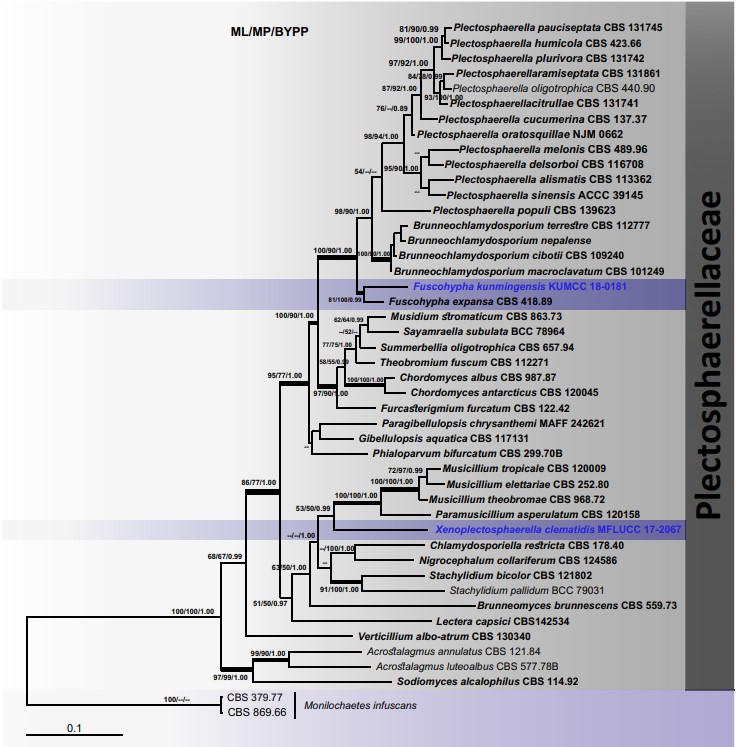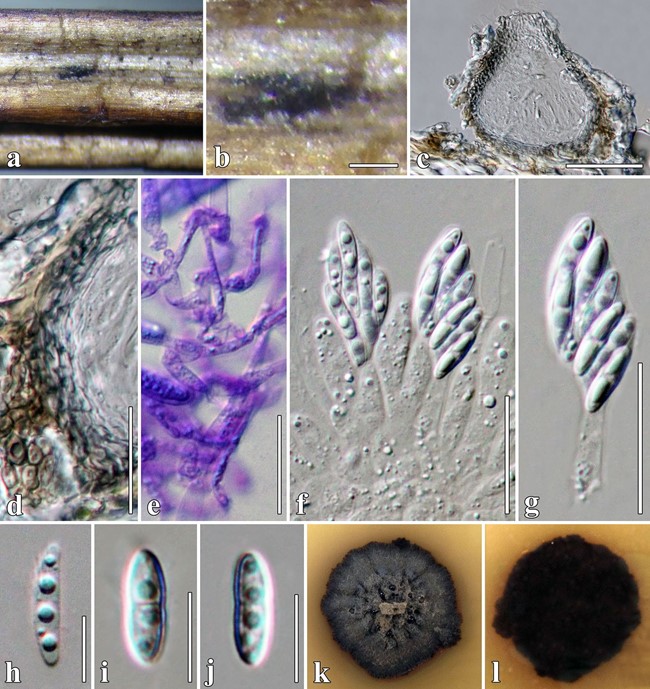Xenoplectosphaerella Jayaward., Phukhams., & K.D. Hyde, gen. nov.
Index Fungorum number: IF557303; Facesoffungi num- ber: FOF 01334, Fig. 115.
Etymology: Name refers to the similarity of its morphol- ogy to Plectosphaerella.
Saprobic on herbaceous plant in terrestrial habitats.
Sexual morph: Ascomata single or gregarious, erumpent or immersed under the host epidermal layer, visible as black spot on host substrate, papillate. Papilla filled with peri- physes. Peridium composed of thin-walled cells of textura angularis mixed with textura globosa, multilayered, inner layers, hyaline. Paraphyses numerous, septate. Asci uni- tunicate, broad clavate to spathulate, with simple pedicel, conspicuous apical or subapical, J-, ring. Ascospores biseri ate, overlapping, fusiform-elliptical to ellipsoid, 1 septum, hyaline, constricted at the septum, straight or slightly curved towards the apex.
Asexual morph: Undetermined.
Type species: Xenoplectosphaerella clematidis Jaya- ward., Phukhams., & K.D. Hyde
Notes: – Xenoplectosphaerella is introduced as a mono- typic genus in Plectosphaerellaceae (Fig. 115). The genus was associated with a herbaceous plant in Thailand and formed obpyriform, coriaceous ascomata with papilla, with paraphyses, and uniquely spathulate asci (Carlucci et al. 2012; Grum-Grzhimaylo et al. 2016; Giraldo et al. 2019). In the BLASTn search of GenBank, the closest match of the LSU region of the new species was Musicillium theo- bromae (CBS 968.72) with 97.22% similarity (accession number LR025907). The closest match of the ITS region of MFLUCC 17–2067 was also M. theobromae (CBS 968.72) with 90.83% similarity (accession number NR_156205). However, Musicillium is phylogenetically distant from our new isolate (Fig. 114). Phylogenetic analyses of sequence data of taxa within Plectosphaerellaceae resolves Xenoplec- tosphaerella as basal to Musicillium and Paramusicillium, which are strains isolated from soil and monocotyledons or the mushroom genus Lactarius sp. (Giraldo et al. 2019). We name our collection as Xenoplectosphaerella clematidis MFLUCC 17–2067, a new genus which formed a distinct lineage from other genera in the family (Fig. 114).

Fig. 114 The best scoring RAxML tree with a final likelihood value of − 23259.637010 of ITS, LSU, tef1 and rpb2 sequence data for Plectosphaerellaceae. The topology and clade stability of the com- bined gene analyses was compared to the single gene analyses. The tree is rooted at Monilochaetes infuscans (CBS 379.77 and CBS 869.66). The matrix had 1093 distinct alignment patterns, with 13.22% of undetermined characters and gaps. Estimated base fre- quencies were as follows; A = 0.224235, C = 0.297727, G = 0.281301, T = 0.196738; substitution rates AC = 0.820050, AG = 1.988895, AT = 1.053617, CG = 0.783458, CT = 5.160854, GT = 1.000000; gamma distribution shape parameter α = 0.2928059. The new species in this study are indicated in blue. Bootstrap values (BS) greater than 50% BS (maximum likelihood (left); maximum parsimony (middle)) and Bayesian posterior probabilities (BYPP, right) greater than 0.90 are given at the nodes. Hyphens (-) represent support values less than 50% BS/0.90 BYPP. Thick branches represent significant support val- ues from all analyses (BS ≥ 70%/BYPP ≥ 0.95) at the genus level

Fig. 115 Xenoplectosphaerella clematidis (MFLU 17–1475, holo- type). a Appearance of ascomata on Clematis subumbellata. b Close up of ascoma on host substrate. c Vertical section through ascoma. D Peridium. e Paraphyses (in cotton blue). f, g Asci. h–j Ascospores. k, l Culture characteristics on MEA. Scale bars: b = 100 µm, c = 50 µm, d–g = 20 µm, h–j = 10 µm
Species
